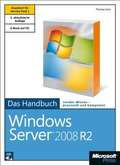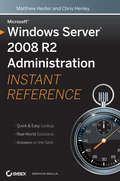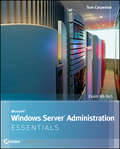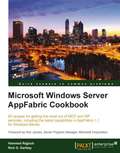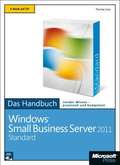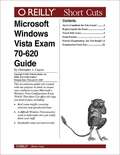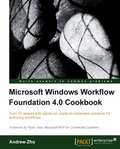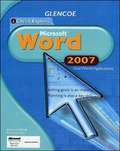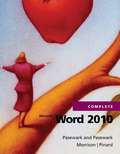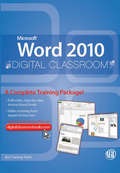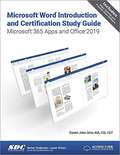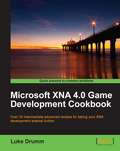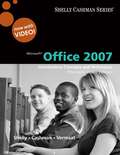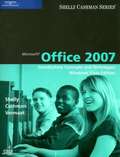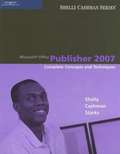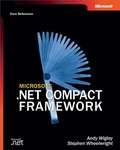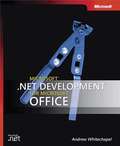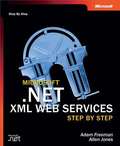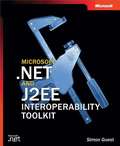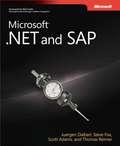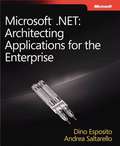- Table View
- List View
Microsoft Windows Server 2008 R2 - Das Handbuch, 2. Auflage, erweitert für Service Pack 1
by Thomas JoosDieses Buch gibt Ihnen einen tiefgehenden Einblick in den praktischen Einsatz von Windows Server 2008 R2 mit Service Pack 1. Es richtet sich sowohl an Neueinsteiger in Microsoft-Servertechnologien als auch an Umsteiger von Vorgängerversionen. Planung und Migration, Konzepte und Werkzeuge zur Administration sowie die wichtigsten Konfigurations- und Verwaltungsfragen werden praxisnah behandelt. Die Funktionalitäten der R2-Version mit Service Pack 1 werden ausführlich vorgestellt, ebenso die effiziente Zusammenarbeit mit Windows 7-Clients. Das E-Book auf CD enthält zusätzlich Kapitel zu Microsoft SharePoint. 1600 Seiten umfangreiches, verständliches und praxisorientiertes Softwarewissen in seiner besten Form: Microsoft Windows Server 2008 R2 mit SP1 -- Das Handbuch.
Microsoft Windows Server 2008 R2 Administration Instant Reference
by Matthew Hester Chris HenleyAll your Windows Server 2008 R2 questions answered--on the spot Get up to speed on the new features of Windows Server 2008 R2 with this indispensableguide. Designed for busy IT professionals, it's the perfect go-to resource for quick answers and real-world solutions as you administer the new server OS. You'll find easy-to-read lists, quick-reference tables, helpful thumb tabs, and much more in a handy, compact format that puts the information you need at your fingertips. Topics include: Getting started and adding roles and functionalityAutomating tasksManaging users, groups, directories, and the centralized desktopHandling folder security, disk management, storage, backup, and recoveryMonitoring and maintaining web serversTroubleshooting IP and managing remote accessDoing performance tuning and maintaining virtual servers
Microsoft Windows Server Administration Essentials
by Tom CarpenterThis book is for current or aspiring professionals seeking a quick grounding in the fundamentals of administration in a Microsoft Windows Server environment. It provides quick, focused coverage of fundamental skills. If you want to start a career in server administration or are already working in the field and want to fill in some gaps on fundamental topics, this book is for you.
Microsoft Windows Server AppFabric Cookbook
by Hammad Rajjoub'Microsoft Windows Server AppFabric Cookbook' is full of immediately useable recipes showing you how to get the most from WCF and WF services using Windows Server AppFabric, leveraging the right capabilities for building composite solutions on the .NET platform. In addition to its cookbook style, which ensures the solutions are presented in a clear step-by-step manner, its explanations go into the right level of detail, making it good learning material for everyone who has experience with some of the challenging aspects of WCF and WF development from a scalability, configuration and management perspective. The book is designed in such a way that each recipe is presented as a separate, standalone entity and reading of other, prior recipes is not required. If you are a .NET developer or WCF/WF developer, then this book is for you. This book does not assume any prior knowledge of Windows AppFabric. However, a basic understanding of .NET Framework 4.0, Windows Communication Foundation (WCF) and Windows Workflow Foundation (WWF) technologies is required.
Microsoft Windows Small Business Server 2011 Standard - Das Handbuch
by Thomas JoosMit diesem Buch wird Administratoren und Beratern, die noch keine umfassenden Kenntnisse über die Funktionen von Small Business Server 2011 haben, eine Hilfestellung an die Hand geben, den Server zu installieren, zu verwalten und Fehler zu beheben. In den einzelnen Kapiteln erhalten Sie ausführliche Anleitungen, wie Sie Small Business Server 2011 im Unternehmen installieren und einsetzen können, wobei nicht nur Vorgehensweisen beschrieben werden, sondern in den einzelnen Bereichen gezielt auf die technischen Hintergründe eingegangen wird. Small Business Server 2011 bietet für die Einrichtung und die Verwaltung zahlreiche Assistenten. Dennoch ist es unerlässlich, dass auch die technischen Grundlagen des Servers verstanden werden. Hier finden Sie die notwendigen Informationen, um Small Business Server 2011 zu beherrschen. Dieses Buch soll Ihnen eine echte Hilfe sein, den Server zu installieren, zu verwalten, aber auch Fehler zu beheben oder Ausfallkonzepte zu erstellen.
Microsoft Windows Vista Exam 70-620 Guide
by Christopher A. CraytonThis no-nonsense guide was created with one purpose in mind: to ensure your readiness to pass Microsoft's Windows Vista Configuration Exam 70-620. This Short Cut offers the edge you need to pass, including:Real exam insight, covering structure and question formatsA difficult Windows Vista practice exam to help make sure you really know your stuffInvaluable exam survival test tips
Microsoft Windows Workflow Foundation 4.0 Cookbook
by Andrew ZhuThis is a fast-paced and to-the-point handbook, it takes you through the important aspects that you need to know when working with Windows WF. The range of topics that we cover in this book is driven by what the working developer needs to know. It is neither a comprehensive reference to the whole WF architecture, nor a strategic guide to the complete application development lifecycle. If you find yourself working with Windows Workflow Foundation 4.0 and you have basic knowledge of C#/.NET Framework/ VB and workflow, this book is for you. It will be best if you know both C# and VB, because WF 4.0 expression can only be written in VB (at the time of writing). With this book, you will be able to enhance your applications with flexible workflow capabilities using WF 4.0. To follow the recipes, you will need to be comfortable with .NET Framework, C# programming, basics of SOA, and how to develop them.
Microsoft Word 2007, Real World Applications
by C. Jacqueline Schultz Linda WooldridgeGlencoe's Microsoft Word 2007 is an engaging top-bound text which provides students with applications that apply to everyday life! Written specifically for high school students, this rigorous express series provides extensive step-by-step exercises and projects that prepare students for MCAS certification. It is age-level and interest-level appropriate. The student edition includes integration of basic language arts and mathematics skills.
Microsoft Word 2010 Complete
by Beth Pasewark Wadsworth Carolyn Denny Pasewark Jan Pasewark Stogner Katherine T. Pinard Scott G. Pasewark Connie Morrison William R. Pasewark Sr. William R. Pasewark Jr.Microsoft Word 2010 Complete provides a thorough introduction of Microsoft Word 2010 skills to beginning learners. This text includes features that make learning easy and enjoyable, yet challenging for students. Students will be engaged with activities that range from simulations to case studies that challenge and sharpen problem-solving skills while gaining the hands-on practice needed to be confident and successful computer users.
Microsoft Word 2010 Digital Classroom (Digital Classroom #93)
by AGI Training TeamThe perfect book-and-video training package for Word 2010! This Word 2010 book-and-video training package-from the same professional training experts who also create many training materials for Adobe Systems-is like having your own personal instructor guiding you through each lesson, but you work at your own pace! The full-color ebook includes 8 lessons that teach you the new features and quirks of Microsoft Word 2010. Each lesson includes step-by-step instructions and lesson files, and provides valuable video tutorials that complement what you're learning and clearly demonstrate how to do tasks. This jam-packed training package takes you well beyond the basics in a series of easy-to-absorb, five-minute lessons. Walks you through 8 lessons, each consisting of easy-to-follow, step-by-step instructions and lesson files in full color that make each task less intimidating Includes all the lesson files from the book and video tutorials that clearly show you how to do tasks and reinforces what you're learning in the book Covers exciting new Word 2010 features such as Office Web apps that can be accessed from anywhere and a streamlined new Ribbon Provides the perfect, one-stop, robust learning package-with book and supplementary video training Additional resources available on companion Web site: www.digitalclassroombooks.com Learn the ins-and-outs of Word 2010!
Microsoft Word 2013 (Learn-by-Doing)
by The Development Team at B.E. Publishing and Martha McGuinnessIncludes over 35 hands-on lessons and unit assessments designed for today's interactive, visual learner.
Microsoft Word 2013: Comprehensive
by Jill MurphyIn today's digital world, knowing how to use the most popular suite of desktop software applications is critical. The book aims to teach new users how to take advantage of this technology and to help experienced users understand how the applications have changed from previous versions. The online student resource center that accompanies this book contains Concepts Review quizzes, student exercise files, and other learning tools.
Microsoft Word Introduction and Certification Study Guide: Microsoft 365 Apps and Office 2019
by Daniel John StineCombining two books in one, Microsoft Word Introduction and Certification Study Guide serves as a training guide for Microsoft Word and a study guide for the Word Certification Exam. Students, professionals, beginners and more experienced users alike can all benefit from this manual. Learn how to create well-formatted, high-quality documents by following along with chapters that focus on six exam topics. These topics closely follow what is needed to ace the exam but also provide comprehensive information for everyday Word users. Careful descriptions and helpful tips for when and how to use important features are provided. Images and screenshots make the steps easy to follow and remember. Each topic starts out with the basics and builds to more complicated steps. Those taking the exam will find practical tips on how to locate a testing center, register for the exam, and get the best score possible, along with study materials including practice exam software and video tutorials for every outcome in the book. Whatever your reason for studying Word, this manual will develop your skills, bolster gaps in your knowledge, and give you the confidence to get certified. Why certification is important Microsoft Word Certification is an easily verifiable way to showcase your willingness to learn new skills and software, and it provides a myriad of other benefits as well. Not only can certification enhance your Word skills, it can help you get hired, boost academic performance, prepare for the demands of a job, open doors to career opportunities, and be more productive and confident working on projects at school, home, or work. Microsoft Word (Microsoft 365 Apps and Office 2019) certification is the first step to prove your skill level and open doors to career opportunities. Outline of the book The dual nature of this book helps you build a strong foundation in Word and prepares you for the exam. The first chapter gets you started right away opening Word and learning about the user interface and important terminology. For those interested in taking the exam, it includes how to register for the exam and find an exam center, tips on using your time wisely during the exam, and information on scores and retaking the exam. The next six chapters cover all of the topics you need to become proficient in Word and coincide with the objective domain categories in the Microsoft Word Certification Exam: Manage Documents; Insert and Format Text, Paragraphs, and Sections; Manage Tables and Lists; Create and Manage References; Insert and Format Graphic Elements; and Manage Document Collaboration. Short video tutorials are included for every single outcome in the book, 95 in all, for when you need extra help or learn best by observation. Word practice exam software included Unlike any other Word exam manual available, this book includes Word practice exam software. The final chapter focuses on the practice exam software, which closely mimics the format of the real exam. Custom-built and specially designed by SDC Publications, this practice exam software can be taken multiple times so you are comfortable with the real test software, how to mark and return to questions, question format, live in-application steps, and how the results are presented.
Microsoft XNA 4.0 Game Development Cookbook
by Luke Drumm"Microsoft XNA 4.0 Game Development Cookbook" is a fast-paced cookbook for taking your knowledge of the framework further with advanced game development tasks. Packed with step-by-step instructions and screenshots, the book will solve an experienced developer's everyday coding problems. If you are an XNA developer who has already successfully mastered simple 2D and 3D XNA tasks, dive into "Microsoft XNA 4.0 Game Development Cookbook" for something more challenging. You should be comfortable with the basics of the XNA framework, and have experience with C#.
Microsoft in the Mirror: Nineteen Insiders Reflect on the Experience
by Karin CarterFormer and current employees of Microsoft share their experience.
Microsoft: Word 2013 Plain & Simple
by Jay Freedman<p>With this full-color, no-nonsense guide, you'll learn the quickest ways to solve a problem or learn a skill with Microsoft Word 2013. Easy-to-follow steps and concise, straightforward language make learning plain and simple!</p>
Microsoft© Office 2007: Introductory Concepts and Techniques, Premium Video Edition
by Gary B. Shelly Thomas J. Cashman Misty E. VermaatIn Microsoft Office 2007: Introductory Concepts and Techniques, Premium Video Edition you'll find exciting videos, which correlate to the Table of Contents and mirror the step-by-step pedagogy of the Microsoft Office 2007: Brief Concepts and Techniques text to reinforce the skills taught in each chapter.
Microsoft© Office 2007: Introductory Concepts and Techniques, Windows Vista Edition
by Gary B. Shelly Thomas J. Cashman Misty E. VermaatNIMAC-sourced textbook
Microsoft© Office Publisher 2007: Complete Concepts and Techniques
by Gary B. Shelly Thomas J. Cashman Joy L. StarksMicrosoft Publisher 2007: Complete Concepts and Techniques provides a project-based, step-by-step approach to teaching Publisher 2007.
Microsoft® .NET Compact Framework (Core Reference)
by Andy Wigley Mark Sutton Stephen Wheelwright Rory Macloed Robert BurbridgeThe Microsoft® Windows® .NET Compact Framework brings the power of the .NET Framework to handheld devices such as Pocket PCs and smart phones. Learn exactly how to build killer applications--and how to solve typical problems--in developing for resource-constrained devices with this book. You'll find specifics on how to develop GUI elements with Windows Forms, access and store data with Microsoft ADO.NET and integrate it across the enterprise with XML Web services, work with Microsoft SQL ServerTM CE, develop applications that connect and disconnect across wireless networks, and more--all with working code samples. You even get a quick reference to the differences between the .NET Compact Framework and the full .NET Framework. Topics covered include: Introducing the Windows .NET Compact Framework and architecture Developing applications with the Compact Framework GUI development with Windows Forms and building Windows Forms applications *Testing, debugging, completing, and distributing your applications Collection classes Working with dates and strings Working with XML Input and output Networking Application security features Accessing data Working with ADO.NET data objects Working with XML Web services Integrating data with SQL Server and using SQL Server CE Building custom controls Globalization and localization Multithreading Graphics programming Interoperating with native code Migrating embedded Visual Tools applications
Microsoft® .NET Development for Microsoft Office
by Andrew WhitechapelCreate Microsoft Office-based applications that work seamlessly in the Microsoft .NET environment--with this essential reference from Microsoft developer Andrew Whitechapel. The author provides expert advice on the various approaches you can use to build managed solutions with Office, and gives practical guidance on the most viable techniques for technical and business scenarios. You'll begin building custom .NET-based applications with detailed, practical exercises that take you through solutions from beginning to end. Andrew shares tactics, strategies, and best practices--plus full sample code--to help you maximize your development efforts. Packed with the same information used by Microsoft's Product Support Services team, this book is the one reference that every Office and .NET developer should have. Discover how to: Develop powerful .NET solutions for Office with managed interop assemblies Integrate managed code with Microsoft Visual Basic for Applications (VBA) Create custom commands and functionality with managed COM and Automation add-ins Build custom Office features with external data using Web services, .NET remoting, and research services Use Microsoft Visual Studio Tools for Office to create document-centric solutions for Microsoft Excel and Word Use digital signatures, strong-naming and .NET Code Access Security Control Office applications using Platform Invoke, Reflection, drag-and-drop, and the IAccessible interface Develop managed Smart Tags and managed Smart Document solutions Covers Microsoft Office 97, Office 2000, Office XP, and Microsoft Office System 2003 Editions
Microsoft® .NET XML Web Services Step by Step
by Adam Freeman Allen JonesXML Web services are the next logical step in the evolution of the Internet. Teach yourself how to write and deploy XML Web services for Microsoft® .NET--one step at a time--with this modular, accessible tutorial. It delivers expert, task-based instruction plus a real-world XML service example to help you apply what you already know about Microsoft Visual C#TM, Microsoft Visual Basic® .NET, and object-oriented programming so that you can learn XML Web services development at your own pace. Topics covered include: UNDERSTANDING XML WEB SERVICES XML Web services architecture XML Web services protocols Web Service Description Language (WSDL) Discovering XML Web services BUILDING XML WEB SERVICES Writing .NET XML Web services Testing XML Web services Debugging XML Web services CONSUMING XML WEB SERVICES Discovering XML Web services Generating a proxy class Creating clients that consume XML Web services Consuming XML Web services asynchronously Consuming XML Web services with HTTP ADVANCED XML WEB SERVICES Managing XML Web service state Securing XML Web services Using data sets with XML Web services Using SOAP headers
Microsoft® .NET and J2EE Interoperability Toolkit
by Simon GuestDiscover how to build applications that run on both the Microsoft .NET Framework and Java 2 Enterprise Edition (J2EE)--and extend your customer reach and system shelf life. Whether your background is in .NET or J2EE, you'll learn to implement many of the interoperability technologies available today, including Microsoft, Sun, and third-party compatibility tools. Interoperability expert Simon Guest takes a balanced look at the pros and cons of each cross-platform technology presented, including best practices, workarounds, and examples of interoperability solutions in action. You also get interoperability software on CD--plus a wealth of code you can use in your own solutions. Discover how to: Use .NET Remoting to enable interplatform connectivity Write interoperable Web service solutions that show interoperability in a production environment, handle exceptions, and use UDDI Employ Microsoft SQL Server 2000 to create a shared database between .NET and J2EE Enable cross-platform asynchronous calling with Microsoft Message Queuing (MSMQ) and WebSphere MQ from IBM Implement a bridge between .NET and J2EE queues using Microsoft Host Information Server and Microsoft BizTalk Server Deliver a consistent user interface across platforms through shared session state and shared authentication Build complex interoperability solutions using Web services specifications for security, binary data exchange, and routing Get code samples and software on CD CD features: The Mind Electric (TME) GLUE Web Services Ja.NET bridging software from Intrinsyc Sample interoperability code from Microsoft A Note Regarding the CD or DVD The print version of this book ships with a CD or DVD. For those customers purchasing one of the digital formats in which this book is available, we are pleased to offer the CD/DVD content as a free download via O'Reilly Media's Digital Distribution services. To download this content, please visit O'Reilly's web site, search for the title of this book to find its catalog page, and click on the link below the cover image (Examples, Companion Content, or Practice Files). Note that while we provide as much of the media content as we are able via free download, we are sometimes limited by licensing restrictions. Please direct any questions or concerns to booktech@oreilly.com.
Microsoft® .NET and SAP
by Scott Adams Juergen Daiberl Steve Fox Thomas ReimerGet hands-on answers to frequently asked questions about using Microsoft .NET technologies to customize and extend SAP applications. Walk through dozens of real-world examples--from Web Services integration to business intelligence (BI) reporting and Microsoft Office-based solutions--direct from a team of Microsoft-SAP interoperability experts. Learn how to expose back-end SAP data through familiar Microsoft tools and UIs--for better productivity and lower TCO. Discover how to: Navigate the development environment and tools--including Microsoft Visual Studio®, Visual Studio Tools for Office, and BizTalk® Server Connect .NET and SAP via Web Services, tools like SAP Connector and Enterprise Service Explorer, and .NET Data Provider Implement BI solutions that unlock SAP data through familiar Microsoft UIs Expose data from SAP NetWeaver Portal in Microsoft Office SharePoint® Server Use the Business Data Catalog to display and search SAP content--no coding Build your own Office Business Applications (OBAs), or put Duet to work Add Microsoft Office presence functionality and forms solutions to SAP applications Deliver a single sign-on solution
Microsoft® .NET: Architecting Applications for the Enterprise
by Dino Esposito Andrea SaltarelloMake the right architectural decisions up front--and improve the quality and reliability of your results. Led by two enterprise programming experts, you'll learn how to apply the patterns and techniques that help control project complexity--and make systems easier to build, support, and upgrade--right from the start. Get pragmatic architectural guidance on how to: Build testability, maintainability, and security into your system early in the design Expose business logic through a service-oriented interface Choose the best pattern for organizing business logic and behavior Review and apply the patterns for separating the UI and presentation logic Delve deep into the patterns and practices for the data access layer Tackle the impedance mismatch between objects and data Minimize development effort and avoid over-engineering--and deliver more robust results Get code samples on the Web.
